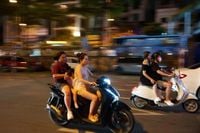Hanoi, Vietnam is on the edge of a dramatic shift in its urban landscape as the city readies itself to ban fossil-fuel motorcycles from its central districts by July 2026. This bold policy, as reported by The Associated Press and Nikkei Asia, is part of a sweeping national push to cut emissions, clean up air quality, and pave the way for electric vehicles to dominate Vietnam’s bustling streets. The country’s commercial capital, Ho Chi Minh City, is not far behind, actively considering a similar ban and laying out plans to replace hundreds of thousands of gasoline-powered bikes with electric alternatives in the coming years.
Vietnam’s relationship with motorbikes runs deep. With a population of roughly 97 million and about 77 million motorbikes nationwide, these two-wheelers are woven into the fabric of everyday life. In Hanoi alone, there are about 7 million motorbikes, while Ho Chi Minh City counts around 8.5 million. They’re more than just vehicles; they’re the engines of commerce, the backbone of family routines, and, for many, a symbol of freedom and mobility. Shopkeepers load goods onto scooters to dodge traffic jams, while families—sometimes three generations deep—pile onto a single bike for the school run. It’s no wonder the gas-powered motorbike has been dubbed the “iron horse” by riders like Ta Manh Cuong, a 45-year-old ride-hailing driver who relies on his battered but dependable steed to make a living. “But right now I can’t afford to buy an electric bike,” Cuong told The Associated Press, highlighting the cost barrier many face.
But the winds of change are blowing. By 2030, Vietnam aims for one-third of its cars and over 20% of its motorbikes to be electric. While electric motorbikes currently make up only about 12% of the market, the government’s ambitious targets and looming bans have already begun to shift consumer behavior. Sales of electric bikes have skyrocketed—up 89% for smaller e-bikes and a staggering 197% for full-sized models in the first eight months of 2025, according to MotorcyclesData. Local manufacturer VinFast has seized the moment, with sales more than quadrupling and the company surpassing regional players like Yadea. VinFast is now poised to launch its first battery-swapping electric motorbike, priced around $760, and is planning to roll out 150,000 battery-swapping stations across Vietnam within three years. That’s a massive infrastructure play aimed at erasing one of the biggest worries about electric bikes: charging convenience.
The government isn’t stopping at bans. It’s sweetening the deal with subsidies and incentives. In Hanoi, people affected by the ban can get between $120 and $200 in subsidies to buy electric bikes—worth at least $590—depending on their income. Registration and license plate fees for new electric bikes are also waived until 2030. In Ho Chi Minh City, plans are underway to replace 400,000 gasoline motorbikes with electric ones by 2028, starting with a 2026 ban on gas bikes for ride-hailing and delivery services. Low-interest loans, tax breaks, and designated low-emission zones are all on the table to help smooth the transition and curb pollution.
It’s not hard to see why the government is so eager. Air pollution is a silent killer in Vietnam, linked to roughly 70,000 deaths annually according to the Health Effects Institute, a Boston-based nonprofit. Zifei Yang of the International Council on Clean Transportation told Nikkei Asia that electrifying Vietnam’s massive fleet of two-wheelers is “key for cutting tailpipe emissions and clearing smog from the streets.” Unlike the car market, most motorbikes in Vietnam are made locally, so a shift to electric bikes could also boost domestic production, foster innovation, and attract new investment. “These countries look at each other. Look at the experience,” Yang said, suggesting that Vietnam’s transition could serve as a template for other developing nations grappling with similar air quality crises.
Still, not everyone is convinced the transition will be smooth. Gas-powered bikes are not only cheaper and sturdier, but also easier to repair—a big plus for the millions who depend on them for their livelihoods. Many owners fret over the range, affordability, and practicality of electric bikes. Son Nguyen, CEO of Dat Bike, a Vietnamese electric bike startup, acknowledged the importance of government incentives but stressed that “long-term success depends on building products that win on their own merits.” Dat Bike recently raised $22 million from private investors to ramp up production and research, nearly doubling its capital to $47 million.
Major manufacturers are also urging caution. Honda, which commands more than 80% of Vietnam’s motorcycle market and sold about 2.3 million bikes between April 2024 and March 2025, has only recently dipped its toes into electric models. Both Honda and Yamaha—who together dominate the market—have voiced concerns about the 2026 ban, calling it too ambitious and warning that a rushed timeline could put undue strain on consumers and the industry. Through Vietnam’s manufacturers’ association, they’ve argued for a more measured approach, and Yamaha told The Associated Press that it was still reviewing the plan and couldn’t comment yet.
For small businesses, the uncertainty is even more pronounced. Bao Ngoc Cao, who rents motorbikes to expats and tourists, described her reaction as “terrified” when she first heard about the ban. Her business model depends on the affordability of gas bikes, which she rents out for about $80 a month. Losing access to Hanoi’s most popular tourist streets would be a major blow. While she welcomes the promise of cleaner air and healthier streets, she says current subsidies aren’t nearly enough to replace her entire fleet with electric bikes. “We are just waiting to get more clarity and see what happens,” she said.
As for the logistics of going electric, there’s hope on the horizon. Battery-swapping stations—where riders can quickly exchange a depleted battery for a fully charged one—could address concerns about range and charging times. VinFast’s ambitious plan to build a nationwide network of these stations is a testament to the scale of investment and innovation required. Smaller batteries, easier home charging, and falling global battery costs are all trends working in favor of electric adoption, according to industry experts like Yang.
Vietnam’s transition from gas-guzzling “iron horses” to sleek, silent electric bikes is about more than just technology or policy. It’s a test of how a society can balance tradition with innovation, economic realities with environmental imperatives, and the daily needs of millions with the long-term health of a nation. The next few years will reveal whether Vietnam’s gamble pays off—and whether its streets will soon hum with the quiet buzz of electric engines instead of the familiar roar of combustion. For now, all eyes are on Hanoi and Ho Chi Minh City as they chart a new course for the country and, perhaps, for the region at large.






